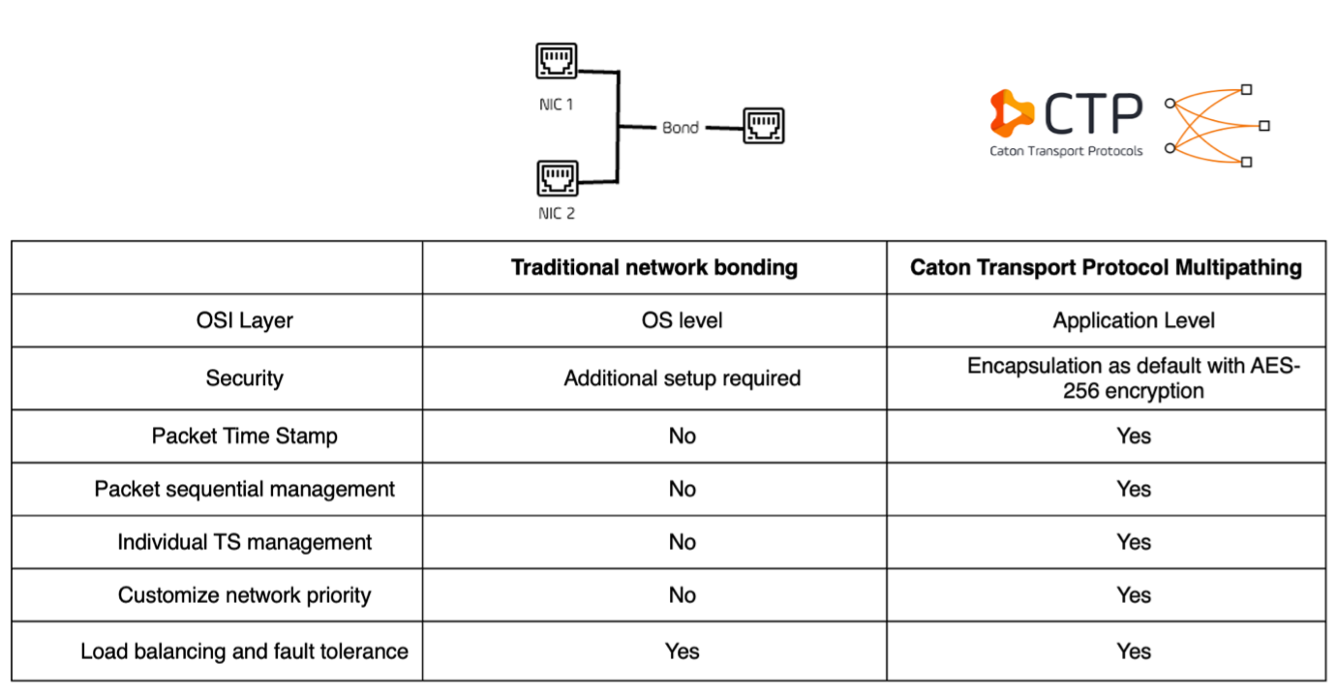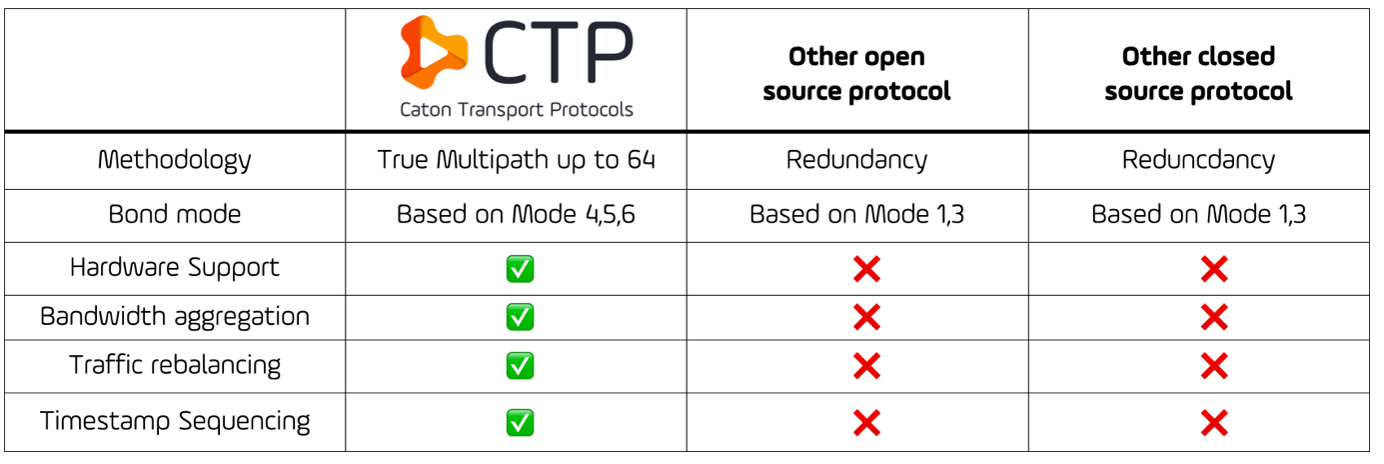Introduction
In today's fast-paced digital world, network bonding has become a crucial aspect of communication infrastructure. Traditional network bonding, which combines multiple wired interfaces into a single bonded interface, offers features like increased throughput, load balancing, and fault tolerance. However, the emergence of new technologies demands more efficient and secure communication methods. This is where Caton Transport Protocols Multipathing (CTP Multipathing) comes into the picture. CTP Multipathing, with its latest technologies, offers high resilience, better stability, and an additional security protection layer, making it superior to traditional network bonding. This white paper aims to provide an overview of network bonding, its different modes, and a comparison between traditional network bonding and CTP Multipathing. We will also discuss how CTP Multipathing offers real-time video transmission and its advantages over traditional network bonding.

Background of Network Bonding
The traditional interface bonding1 allows the aggregation of multiple wired interfaces into a single bonded interface and provides features, such as increased throughput, load balancing and fault tolerance. Bonding is also known as network bonding, link aggregation, port trunking or striping.
The history of the Bandwidth On Demand Interoperability Group (BONDING) standard and its relationship to current and emerging network architectures are discussed2. Applications of bandwidth-on-demand products to videoconferencing, multimedia and LAN interconnection are described with respect to current and future equipment capabilities. Many data transmission applications require transmission at bit rates higher than those available from carriers.
Network bonding offers performance improvements and redundancy by increasing the network throughput and bandwidth. If one interface is down or unplugged, the other one will work. It can be used in situations where you need fault tolerance, redundancy or load-balancing networks. It allows the applications to have greater freedom in selecting the optimum communication bandwidth and cost.
Types of Network Bonding
Based on the development of network bonding1, it has been classified into seven different tiers2 as below:
mode=0 (balance-rr)
This mode is based on the Round-robin policy, and it is the default mode. This mode offers fault tolerance and load-balancing features. It transmits the packets in a Round-robin fashion that is from the first available node through the last.
mode-1 (active-backup)
This mode is based on the Active-backup policy. Only one node is active in this bond, and another will act only when the other fails. The MAC address of this bond is available only on the network adapter part to avoid confusing the switch. This mode also provides fault tolerance.
mode=2 (balance-xor)
This mode sets an XOR (exclusive or) mode that is the source MAC address is XOR’d with the destination MAC address for providing load balancing and fault tolerance. For each destination MAC address, the same node is selected.
mode=3 (broadcast)
This method is based on the broadcast policy, transmitting everything on all node interfaces. It provides fault tolerance. This can be used only for specific purposes.
mode=4 (802.3ad)
This mode, known as a Dynamic Link Aggregation mode, creates aggregation groups with the same speed and duplex setting. It requires a switch that supports IEEE 802.3ad dynamic link. The node selection for outgoing traffic is done based on a transmit hashing method. This may be changed from the XOR method via the xmit_hash_policy option.
mode=5 (balance-tlb)
This mode is called Adaptive transmit load balancing. The outgoing traffic is distributed based on the current load on each node and the incoming traffic is received by the current node. If the incoming traffic fails, the failed receiving node is replaced by the MAC address of another node. This mode does not require any special switch support.
mode=6 (balance-alb)
This mode is called adaptive load balancing. It includes balance-transmit load balancing plus receive-load balancing for IPv4 traffic. This mode does not require any special switch support. The receive-load balancing is achieved by ARP negotiation. The bonding driver intercepts the ARP replies sent by the local system on their way out and overwrites the source hardware address with the unique hardware address of one of the nodes in the bond. Thus, different peers use different hardware addresses for the server.

Caton Transport Protocols Multipathing (CTP Multipathing)
The present innovation of multipathing from Caton provides a real-time video transmission method for a multipath network. The multipath network comprises at least two video stream transmission sub-paths from a transmitting terminal to a receiving terminal. The real-time video transmission method for a multipath network comprises steps:
- By the transmitting terminal, packing original video stream data and sequentially adding a tag into a packet header to obtain multipath transmission data, and sending the multipath transmission data packets to different ones of the video stream transmission sub-paths for transmission.
- By the receiving terminal, receiving and parsing the multipath transmission data packets, and restoring the original video data stream according to the tags in the packet headers.
The present invention can take full advantage of outlet and inlet bandwidths at two ends of a transmission path and can effectively improve stability in video transmission to improve user experience. Read more about the patent here.
Comparison between CTP Multipathing and Traditional Network Bonding
CTP Multipathing is beyond the traditional network bonding with our latest technologies. The multipathing is effective in the application layer and provides an additional security protection layer.
Because of having packet time stamp and packet sequential management, CTP Multipathing enables carrying out individual TS management, load balancing, and fault tolerance compared to traditional networking bonding.

Table 1 - Comparison between Traditional Network Bonding and CTP Multipathing
According to the seven tiers of the network bonding classification, the modes 4 to 6 are relatively new ways of network bonding.
Mode 4 requires the connection of a specific MAC address to provide fault tolerance. At the same time, specific network switches, network programming and the same condition network interface is compulsory. On the other hand, CTP Multipathing does not need the specific network switch and programming, and therefore, it is much easier to set up.
Mode 5 is similar to the CTP Multipathing methodology, which uses adaptive transmit load balancing and provides fault tolerance without a specific network switch. However, Mode 5 requires network programming within the operating system, while CTP Multipathing doesn’t need to do so.
With the development of network bonding, CTP Multipathing is also similar to Mode 6 currently. It bonds the network interface for incoming and outgoing traffic on the operating system level to provide adaptive load balancing. However, the network bonding within the operating system level is insufficient for video transmission without managing the packet transfer sequence.
CTP Multipathing is built on the application level and provides flexibility and availability for video transmission without specific network switches and programming. Besides, CTP encapsulates its data and encrypts the end-to-end connection with AES-128 and AES-256 encryption technologies. For an added layer of security, designated devices can also be assigned for specified whitelisted connections.
Key benefits of CTP Multipathing

By introducing the new CTP Multipathing to Caton Relay Server (CRS), the CRS now has the ability to set up 8 x 8 network connections and form up to 64 paths for a single transmission. It utilises Artificial Intelligence and Machine Learning on the big data collected over the years to learn, adapt and react to the network conditions by the millisecond. Marrying this intelligence to the traffic shaping with auto load balancing and auto-buffering further improves the resilience of the transmission over the public internet, even in the most challenging network conditions.
All of these are performed automatically without the need for physical intervention by the network engineer, thus reducing man-hours and resources. The multipathing also empowers users with the flexibility to customise and prioritise different paths for different applications based on their various needs.
Learn:
- Constantly monitor the network status on every path
- Constantly seek the optimal route for the most efficient transmission
- Intelligently bond multiple networks to increase network throughput and bandwidth
Adapt:
- Automatically perform traffic shaping with auto load balancing and auto-buffering based on the network conditions.
- Flexibility to customise and prioritise different paths for different scenarios and needs
- Ability to set up 8 x 8 network connections and form up to 64 paths
React:
- Automatically switches from the primary to the backup path during unforeseen circumstances
- Integrated with Caton NMS to monitor all paths and perform active alerts
Read more about Caton Transport Protocols (CTP) here.
[1] Aust, Stefan, et al. "Evaluation of Linux bonding features." 2006 International Conference on Communication Technology. IEEE, 2006.
[2] P. H. Fredette, "The past, present, and future of inverse multiplexing," in IEEE Communications Magazine, vol. 32, no. 4, pp. 42-46, April 1994, doi: 10.1109/35.275334.
[3] Classification comes from interserver.net.
[4] Classification comes from IBM.
Do you know of someone who may be interested in this? Share it via:











